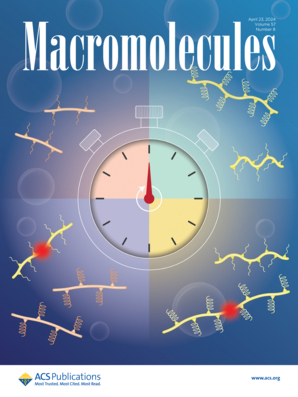Phosphonium Cationic Borneol Stereochemical Membrane Breaking Arrow: High Antibacterial and Antibiofilm Activity
IF 5.2
1区 化学
Q1 POLYMER SCIENCE
引用次数: 0
Abstract
Bacterial biofilm contamination poses a substantial threat to public health and safety while also leading to considerable economic losses. In this study, a series of both offensive and defensive poly(quaternary phosphonium salt-borneol) copolymers (P(QPx-BOy)), utilizing stereochemically structured borneol as the membrane breaking arrow and quaternary phosphonium salt cations as the electrostatic driving force, were successfully synthesized. Notably, this work exemplifies a novel integration of natural borneol with quaternary phosphonium cations. Subsequently, the molecular structure, molecular weight distribution, microstructure, and corresponding physicochemical properties of the P(QPx-BOy) were characterized using NMR, FT-IR, GPC, SEM, EDS, CA, and DLS. Leveraging the electrostatic interaction between the phosphonium cation and the stereochemical antibacterial mechanism of borneol, P(QPx-BOy) exhibited remarkable antibacterial efficacy against both E. coli and S. aureus, achieving a 100% antibacterial rate with MIC value as low as 30 μg/mL. Furthermore, crystal violet staining assays revealed that borneol’s unique antibiofilm mechanism exerts a significant inhibitory effect on bacterial biofilm formation. Finally, the biocompatibility and antibacterial potential of P(QPx-BOy) were evaluated through cytotoxicity assays and fabric antibacterial tests. Specifically, the integration of borneol essential oil with hydrophilic quaternary phosphonium salt cations effectively addresses the hydrophobic nature of borneol essential oil while mitigating the cytotoxic effects associated with quaternary phosphonium salts. This synergistic combination leverages the strengths of both components, thereby enhancing their suitability for applications in healthcare and public health sectors.

膦阳离子硼醇立体化学破膜箭:高抗菌和抗生物膜活性
细菌生物膜污染对公众健康和安全构成重大威胁,同时也导致相当大的经济损失。本研究以立体结构的冰片为破膜箭头,以季磷盐阳离子为静电驱动力,成功合成了一系列攻防型聚(季磷盐-冰片)共聚物(P(QPx-BOy))。值得注意的是,这项工作举例说明了天然冰片与季磷阳离子的新整合。随后,采用NMR、FT-IR、GPC、SEM、EDS、CA、DLS等表征了P(QPx-BOy)的分子结构、分子量分布、微观结构及相应的理化性质。P(QPx-BOy)利用磷离子的静电相互作用和冰片的立体化学抑菌机制,对大肠杆菌和金黄色葡萄球菌均表现出显著的抑菌效果,抑菌率达到100%,MIC值低至30 μg/mL。结晶紫染色实验表明,冰片独特的抗生物膜机制对细菌生物膜的形成有明显的抑制作用。最后,通过细胞毒性试验和织物抗菌试验,评价P(QPx-BOy)的生物相容性和抗菌潜力。具体来说,冰片精油与亲水性季磷盐阳离子的整合有效地解决了冰片精油的疏水性,同时减轻了与季磷盐相关的细胞毒性作用。这种协同组合利用了两个组件的优势,从而增强了它们在医疗保健和公共卫生部门应用的适用性。
本文章由计算机程序翻译,如有差异,请以英文原文为准。
求助全文
约1分钟内获得全文
求助全文
来源期刊

Macromolecules
工程技术-高分子科学
CiteScore
9.30
自引率
16.40%
发文量
942
审稿时长
2 months
期刊介绍:
Macromolecules publishes original, fundamental, and impactful research on all aspects of polymer science. Topics of interest include synthesis (e.g., controlled polymerizations, polymerization catalysis, post polymerization modification, new monomer structures and polymer architectures, and polymerization mechanisms/kinetics analysis); phase behavior, thermodynamics, dynamic, and ordering/disordering phenomena (e.g., self-assembly, gelation, crystallization, solution/melt/solid-state characteristics); structure and properties (e.g., mechanical and rheological properties, surface/interfacial characteristics, electronic and transport properties); new state of the art characterization (e.g., spectroscopy, scattering, microscopy, rheology), simulation (e.g., Monte Carlo, molecular dynamics, multi-scale/coarse-grained modeling), and theoretical methods. Renewable/sustainable polymers, polymer networks, responsive polymers, electro-, magneto- and opto-active macromolecules, inorganic polymers, charge-transporting polymers (ion-containing, semiconducting, and conducting), nanostructured polymers, and polymer composites are also of interest. Typical papers published in Macromolecules showcase important and innovative concepts, experimental methods/observations, and theoretical/computational approaches that demonstrate a fundamental advance in the understanding of polymers.
 求助内容:
求助内容: 应助结果提醒方式:
应助结果提醒方式:


